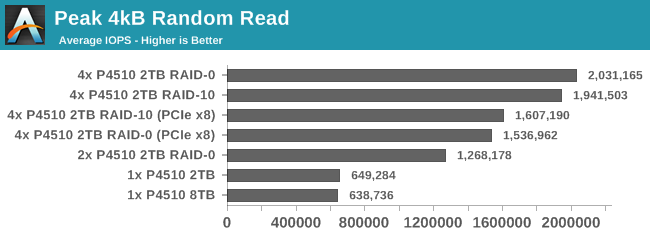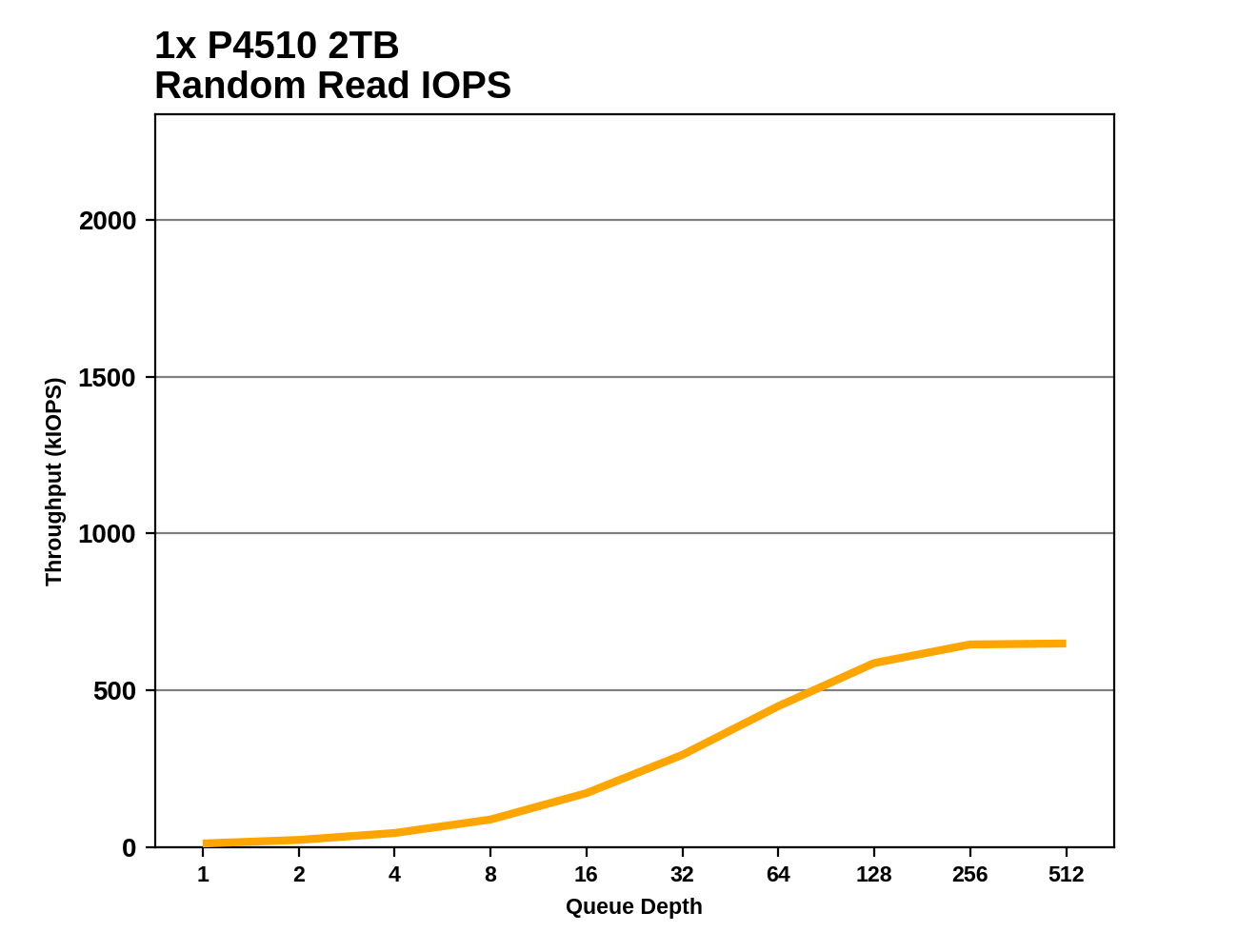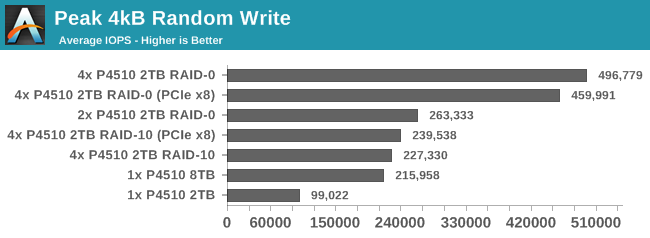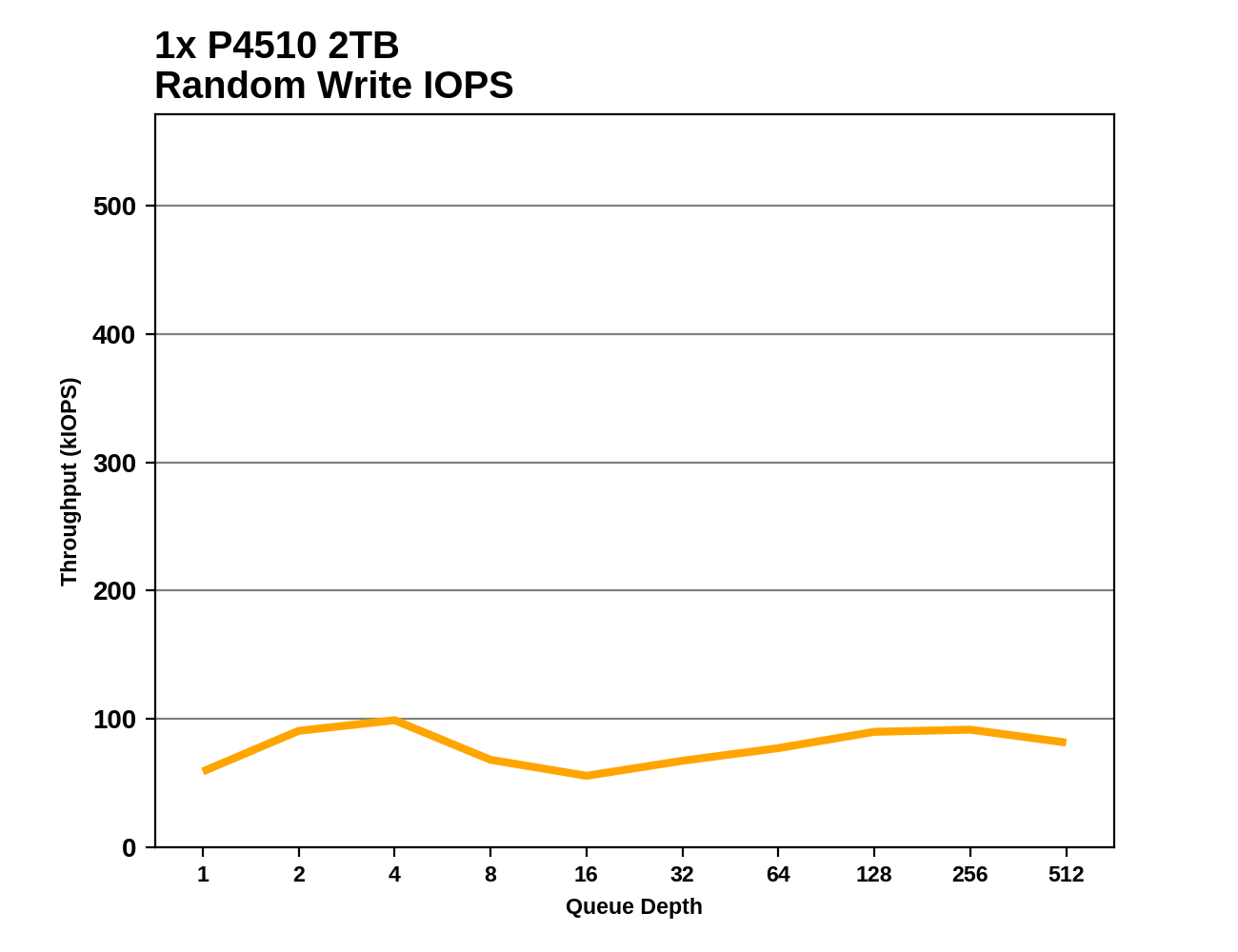The Intel SSD DC P4510 SSD Review Part 1: Virtual RAID On CPU (VROC) Scalability
by Billy Tallis on February 15, 2018 3:00 PM EST- Posted in
- SSDs
- Storage
- Intel
- RAID
- Enterprise SSDs
- NVMe
- U.2
- Purley
- Skylake-SP
- VROC
Random Read Performance
In order to properly stress a four-drive NVMe RAID array, this test covers queue depths much higher than our client SSD tests: from 1 to 512, using from one to eight worker threads each with queue depths up to 64. Each queue depth is tested for four minutes, and the performance average excludes the first minute. The queue depths are tested back to back with no idle time. The individual read operations are 4kB, and cover the span of the drive or array. Prior to running this test, the drives were preconditioned by writing to the entire drive with random writes, twice over.

The 2TB and 8TB P4510s have the same peak random read performance. The RAID-0 and RAID-10 configurations both provide about three times the performance of a single drive, and the two-drive RAID-0 provides just under twice the performance of a single drive.
 |
|||||||||
The individual P4510 drives don't saturate until at least QD128. The RAID configurations with a bottleneck from the PCIe x8 switch uplink have hit that limit by the end of the test, but the four-drive configurations without that bottleneck could clearly deliver even higher throughput with more worker threads.
Random Write Performance
As with the random read test, this test covers queue depths from 1 to 512, using from one to eight worker threads each with queue depths up to 64. Each queue depth is tested for four minutes, and the performance average excludes the first minute. The queue depths are tested back to back with no idle time. The individual write operations are 4kB, and cover the span of the drive or array. This test was run immediately after the random read test, so the drives had been preconditioned with two full drive writes of random writes.

The four-drive RAID-0 configuration manages to provide five times the random write throughput of a single 2TB drive, and even the configuration with a PCIe x8 bottleneck is over four times faster than a single drive. The RAID-10 configurations and the two-drive RAID-0 are only slightly faster than the single 8TB drive, which has more than twice the random write throughput of the 2TB model.
 |
|||||||||
Several of the test runs show performance drops in the second half that we did not have time to debug, but the general pattern seems to be that random write performance saturates at relatively low queue depths, around QD16 or QD32.










21 Comments
View All Comments
MrSpadge - Friday, February 16, 2018 - link
> On a separate note - the notion of paying Intel extra $$$ just to enable functions you've already purchased (by virtue of them being embedded on the motherboard and the CPU) - I just can't get around it appearing as nothing but a giant ripoff.We take it for granted that any hardware features are exposed to us via free software. However, by that argument one wouldn't need to pay for any software, as the hardware to enable it (i.e. a x86 CPU) is already there and purchased (albiet probably from a different vendor).
And on the other hand: it's apparently OK for Intel and the others to sell the same piece of silicon at different speed grades and configurations for different prices. Here you could also argue that "the hardware is already there" (assuming no defects, as is often the case).
I agree on the anti trust issue of cheaper prices for Intel drives.
boeush - Friday, February 16, 2018 - link
My point is that when you buy these CPUs and motherboards, you automatically pay for the sunk R&D and production costs of VROC integration - it's included in the price of the hardware. It has to be - if VROC I is dud and nobody actually opts for it, Intel has to be sure to recoup its costs regardless.That means you've already paid for VROC once - but you now have to pay twice yo actually use it!
Moreover, the extra complexity involved with this hardware key-based scheme implies that the feature is necessarily more costly (in terms of sunk R&D as well as BOM) than it could have been otherwise. It's like Intel deliberately and intentionally set out to gouge its customers from the early concept stage onward. Very bad optics...
nivedita - Monday, February 19, 2018 - link
Why would you be happier if they actually took the trouble to remove the silicon from your cpu?levizx - Friday, February 16, 2018 - link
> However, by that argument one wouldn't need to pay for any software, as the hardware to enable itThat's a ridiculous claim, the same vendor (SoC vendor, Intel in this case) does NOT produce "any software" (MSFT etc). VROC technology in ALREADY embedded in the hardware/firmware.
BenJeremy - Friday, February 16, 2018 - link
Unless things have changed in the last 3 months, VROC is all but useless unless you stick with intel-branded storage options. My BIL bought a fancy new Gigabyte Aorus Gaming 7 X299 motherboard when they came out, then waited months to finally get a VROC key. It still didn't allow him to make a bootable RAID-0 array the 3 Samsung NVMe sticks. We do know that, in theory, the key is not needed to make such a setup work, as a leaked version of Intel's RST allowed a bootable RAID-0 array in "30-day trial mode".We need to stop falling for Intel's nonsense. AMD's Threadripper is turning in better numbers in RAID-0 configurations, without all the nonsense of plugging in a hardware DRM dongle.
HStewart - Friday, February 16, 2018 - link
"We need to stop falling for Intel's nonsense. AMD's Threadripper is turning in better numbers in RAID-0 configurations, without all the nonsense of plugging in a hardware DRM dongle."Please stop the nonsense of fact less claims about AMD and provide actual proof about performance numbers. Keep in mind this SSD is an enterprise product designed for CPU's like Xeon not game machines.
peevee - Friday, February 16, 2018 - link
Like it.But idle power of 5W is kind of insane, isn't it?
Billy Tallis - Friday, February 16, 2018 - link
Enterprise drives don't try for low idle power because they don't want the huge wake-up latencies to demolish their QoS ratings.peevee - Friday, February 16, 2018 - link
4-drive RAID0 only overcomes 2-drive RAID0 by QD 512 . What kind of a server can run 612 threads at the same time? And what kind of server you will need for full 32 Ruler 1U backend (which would require 4192 threads to take advantage of all that power)?kingpotnoodle - Sunday, February 18, 2018 - link
One use could be shared storage for I/O intensive virtual environments, attached to multiple hypervisor nodes, each with multiple 40Gb+ NICs for the storage network.